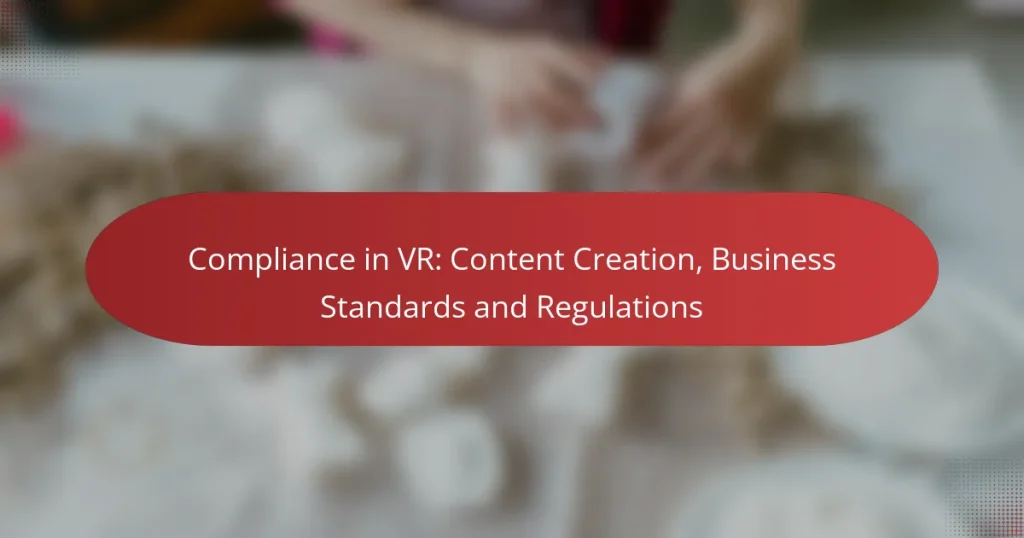Compliance in virtual reality (VR) content creation is crucial for ensuring data security and adherence to industry regulations. In the UK, creators must navigate standards such as ISO 27001 and the Data Protection Act 2018 to deliver secure and legally compliant experiences. By implementing structured processes and utilizing compliance management tools, businesses can effectively address legal and ethical considerations in their VR projects.
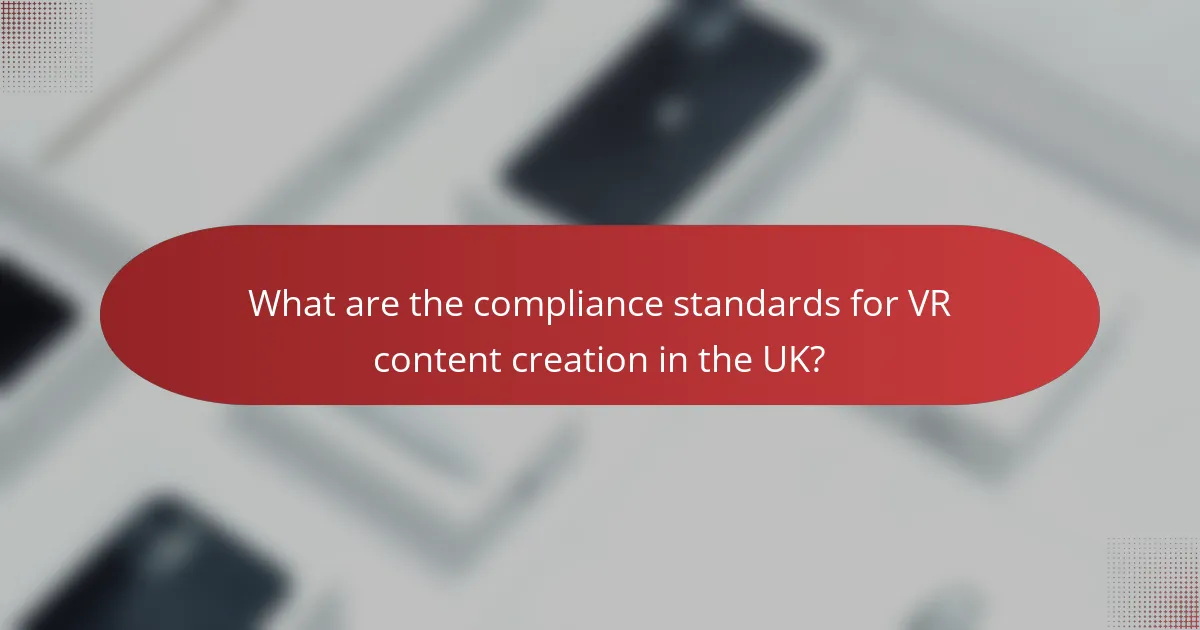
What are the compliance standards for VR content creation in the UK?
In the UK, compliance standards for VR content creation focus on ensuring data security, following industry guidelines, and adhering to data protection laws. Key standards include ISO 27001, BSI guidelines, and the Data Protection Act 2018, which collectively help creators maintain high-quality, secure, and legally compliant VR experiences.
ISO 27001 for information security
ISO 27001 is an international standard that outlines best practices for establishing, implementing, maintaining, and continually improving an information security management system (ISMS). For VR content creators, this means ensuring that all data, including user information and intellectual property, is adequately protected against breaches and unauthorized access.
To comply with ISO 27001, businesses should conduct regular risk assessments, implement security controls, and provide staff training on data protection. This proactive approach not only safeguards sensitive information but also enhances the overall credibility of the VR content produced.
British Standards Institution (BSI) guidelines
The British Standards Institution (BSI) provides guidelines that help organizations develop and maintain quality standards in various sectors, including VR content creation. Following BSI guidelines can improve the reliability and user experience of VR applications by ensuring they meet established benchmarks for quality and safety.
VR developers should familiarize themselves with relevant BSI standards, such as those related to usability and accessibility, to create inclusive content. Regular audits and adherence to these guidelines can help identify areas for improvement and ensure compliance with industry expectations.
Data Protection Act 2018 compliance
The Data Protection Act 2018 governs how personal data is collected, stored, and processed in the UK, aligning with the EU’s General Data Protection Regulation (GDPR). For VR content creators, compliance involves obtaining explicit consent from users before collecting their data and ensuring that data is used transparently and securely.
To comply with this act, businesses should implement clear privacy policies, provide users with access to their data, and establish robust data protection measures. Regular training on data handling practices is essential to avoid potential fines and maintain user trust.
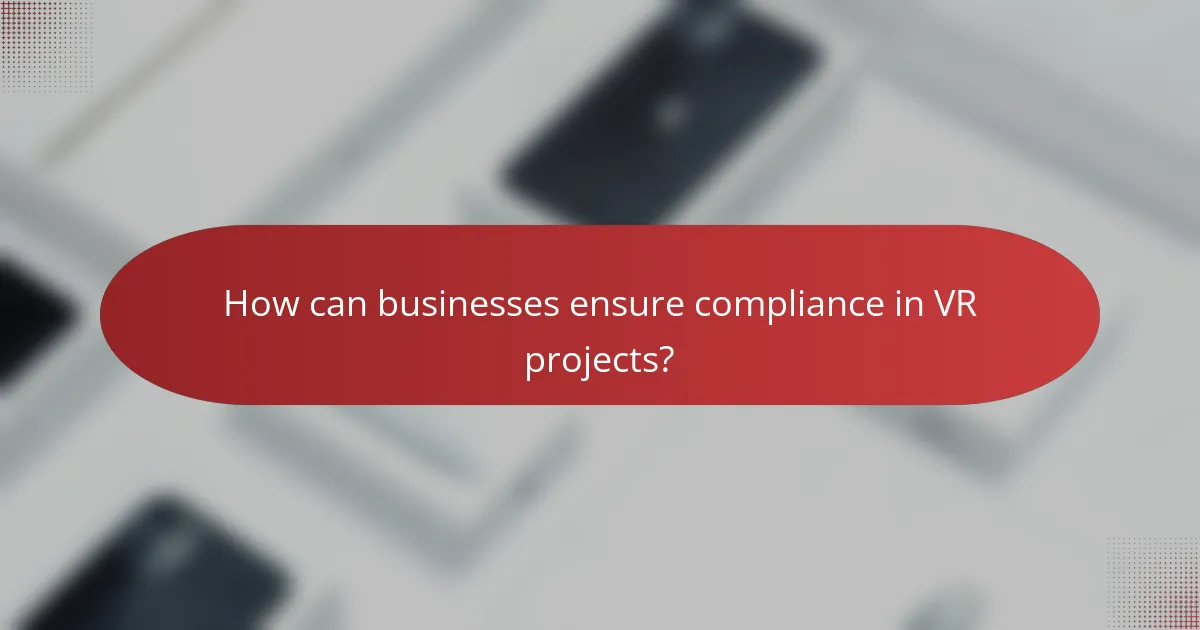
How can businesses ensure compliance in VR projects?
Businesses can ensure compliance in VR projects by implementing structured processes that address legal, ethical, and industry standards. This includes conducting audits, establishing user consent protocols, and utilizing compliance management software to monitor and enforce adherence to regulations.
Conducting regular audits
Regular audits are essential for identifying compliance gaps in VR projects. These audits should evaluate content, user interactions, and data management practices to ensure they align with relevant regulations and standards.
Businesses should schedule audits at least quarterly, but more frequent assessments may be necessary during the development phase. Utilizing checklists can help streamline the audit process and ensure all critical areas are covered.
Implementing user consent protocols
User consent protocols are crucial for protecting user privacy and ensuring compliance with data protection laws. Businesses must clearly inform users about data collection, usage, and sharing practices before obtaining consent.
Effective protocols should include easy-to-understand consent forms, options for users to manage their preferences, and mechanisms for withdrawing consent. Regularly reviewing and updating these protocols is necessary to adapt to changing regulations.
Utilizing compliance management software
Compliance management software can streamline the process of monitoring and enforcing compliance in VR projects. These tools help track regulatory changes, manage documentation, and automate reporting processes.
When selecting compliance software, businesses should consider features such as user-friendly interfaces, integration capabilities with existing systems, and support for specific regulations relevant to their industry. Regular training on the software can enhance its effectiveness and ensure all team members are familiar with compliance requirements.
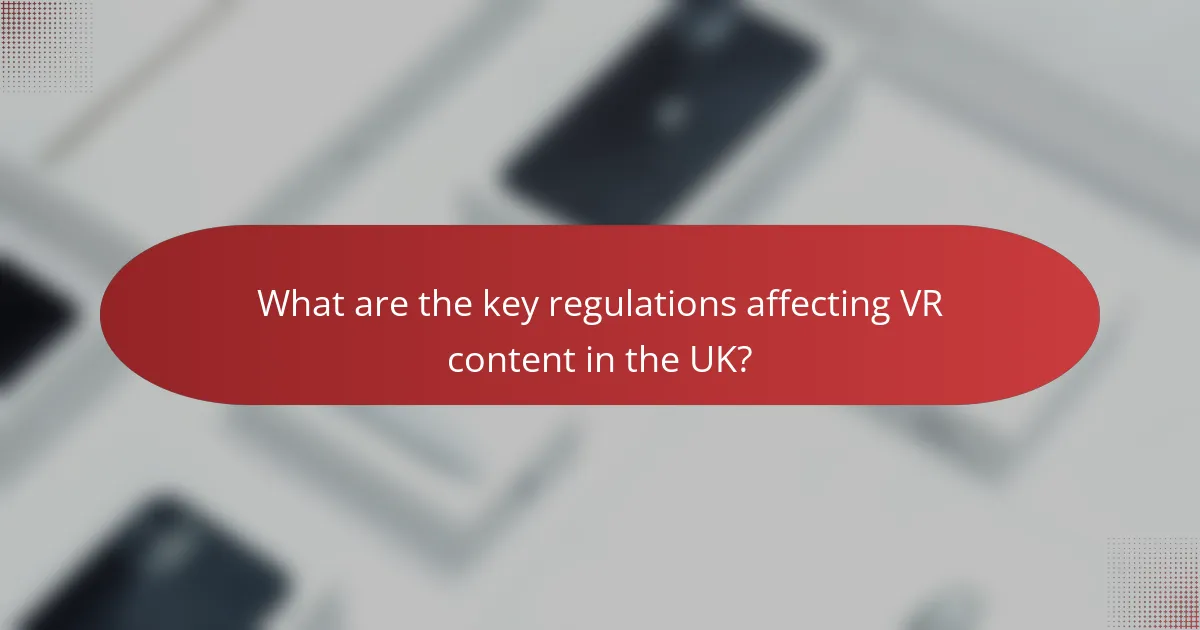
What are the key regulations affecting VR content in the UK?
In the UK, several key regulations impact the creation and distribution of virtual reality (VR) content. These regulations ensure that user data is protected, consumer rights are upheld, and health and safety standards are maintained during VR experiences.
General Data Protection Regulation (GDPR)
The General Data Protection Regulation (GDPR) is a crucial framework that governs how personal data is collected, processed, and stored in the UK. VR content creators must ensure that any personal data collected from users, such as biometric data or usage patterns, complies with GDPR requirements.
Key considerations include obtaining explicit consent from users before data collection and providing clear information on how their data will be used. Non-compliance can result in significant fines, so it is essential to implement robust data protection measures.
Consumer Rights Act 2015
The Consumer Rights Act 2015 protects consumers in the UK by ensuring that products and services, including VR content, are of satisfactory quality and fit for purpose. This means that VR experiences must meet certain standards and provide value to users.
Content creators should be transparent about what users can expect from their VR products, including any limitations or potential risks. Providing clear terms and conditions can help mitigate disputes and enhance consumer trust.
Health and Safety at Work Act 1974
The Health and Safety at Work Act 1974 mandates that employers ensure the health and safety of their employees and users during VR experiences. This includes assessing risks associated with VR use, such as physical injuries or psychological effects.
Developers should conduct thorough risk assessments and implement safety measures, such as providing clear instructions and ensuring that users have adequate space to engage with VR content. Regular safety audits can help maintain compliance and enhance user safety.
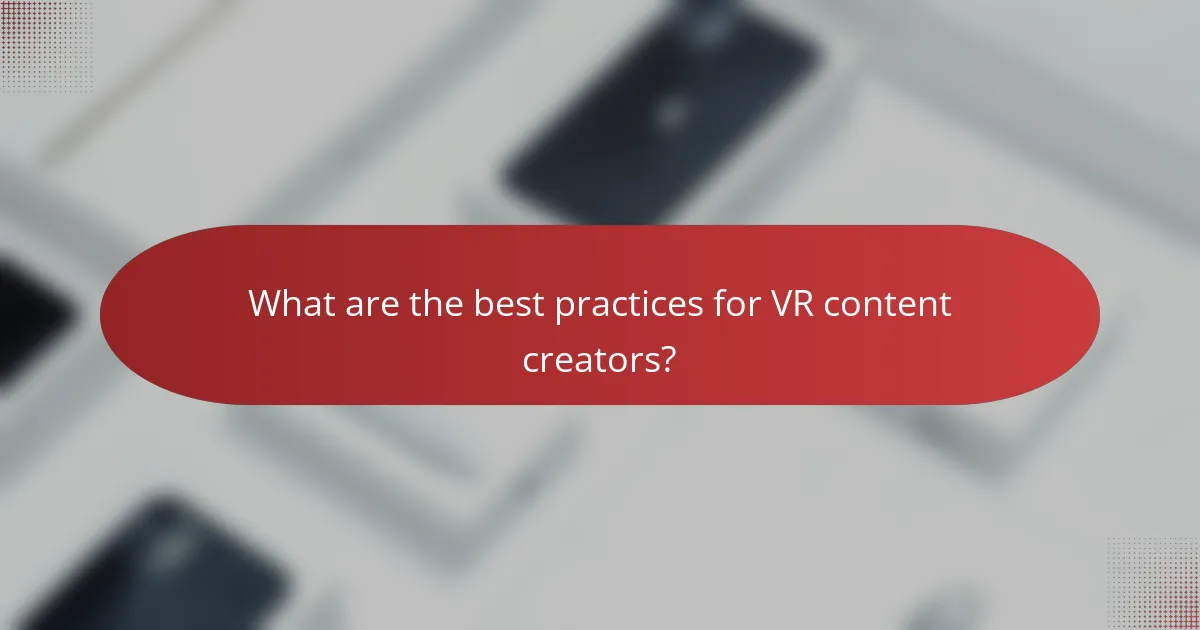
What are the best practices for VR content creators?
The best practices for VR content creators focus on ethical design, accessibility, and compliance. By adhering to these principles, creators can enhance user experience while meeting necessary standards and regulations.
Adopting ethical design principles
Ethical design principles in VR content creation involve prioritizing user well-being and avoiding manipulative practices. This includes ensuring that content does not exploit users’ vulnerabilities or create harmful psychological effects.
Creators should consider the impact of immersive experiences on users, such as motion sickness or disorientation. Implementing features like adjustable settings for comfort can help mitigate these issues and promote a safer environment.
Ensuring accessibility for users
Accessibility in VR means making content usable for individuals with varying abilities. This includes providing options for users with visual or auditory impairments, such as audio descriptions or subtitles.
Creators should follow established guidelines, like the Web Content Accessibility Guidelines (WCAG), to ensure their VR experiences are inclusive. Testing with diverse user groups can reveal potential barriers and help refine the content for broader accessibility.
Regularly updating content for compliance
Regular updates are essential for maintaining compliance with evolving regulations and standards in VR. This includes keeping abreast of legal requirements related to data privacy, user consent, and intellectual property.
Creators should establish a schedule for reviewing and updating their content, ideally every few months. This proactive approach helps avoid legal pitfalls and ensures that the VR experience remains relevant and user-friendly.

What frameworks can guide compliance in VR development?
Compliance in VR development can be guided by various frameworks that ensure adherence to legal, ethical, and industry standards. These frameworks help developers navigate the complexities of regulations and best practices, ultimately fostering safer and more responsible virtual environments.
Compliance checklists
Compliance checklists are practical tools that outline essential requirements for VR development. They typically include items related to user data protection, accessibility standards, and content appropriateness. By following a checklist, developers can systematically verify that their projects meet necessary compliance criteria.
For example, a checklist might include ensuring that user consent is obtained for data collection, verifying that the VR experience is accessible to individuals with disabilities, and confirming that content does not violate copyright laws. Regularly updating checklists to reflect changing regulations is crucial for ongoing compliance.
Risk assessment matrices
Risk assessment matrices help identify and evaluate potential risks associated with VR projects. These matrices categorize risks based on their likelihood and impact, allowing developers to prioritize mitigation strategies effectively. A well-structured matrix can highlight areas requiring immediate attention and resources.
For instance, a risk assessment matrix might classify risks related to user privacy, hardware compatibility, and content safety. By addressing high-impact risks first, developers can create a more secure and compliant VR experience. Regularly reviewing and updating the matrix is essential to adapt to new challenges and regulatory changes.
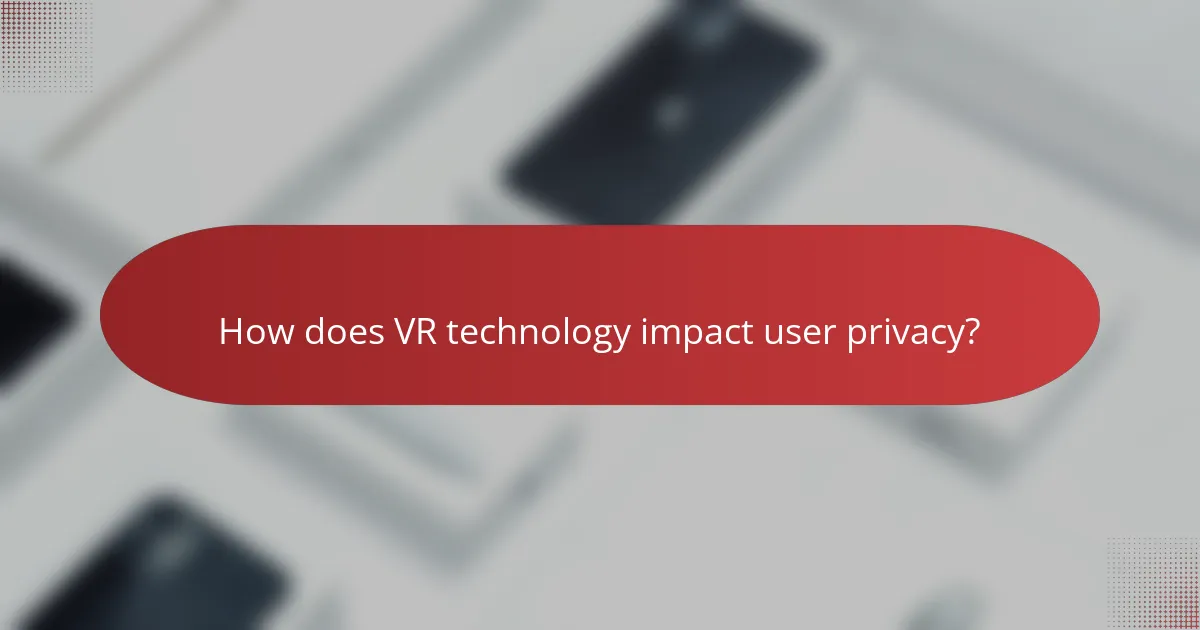
How does VR technology impact user privacy?
VR technology significantly impacts user privacy by collecting vast amounts of personal data, including biometric information and behavioral patterns. This data can be used for targeted advertising, user profiling, and even surveillance, raising concerns about consent and data security.
Data collection methods
In VR environments, data collection occurs through various methods, including sensors, cameras, and user interactions. These technologies can capture information such as eye movement, physical location, and even emotional responses. For instance, VR headsets may track head movements and gestures to enhance user experience but also gather sensitive data.
Common data collection methods in VR include:
- Motion tracking via sensors and cameras
- Voice recognition for commands and interactions
- Biometric data collection, such as heart rate and facial expressions
User tracking implications
User tracking in VR raises significant privacy concerns, as it allows companies to monitor behavior in real-time. This tracking can lead to the creation of detailed user profiles, which may be shared with third parties without explicit consent. Users should be aware that their interactions in virtual spaces can be recorded and analyzed.
To mitigate risks, users should consider the following:
- Review privacy settings in VR applications
- Limit data sharing options where possible
- Stay informed about the data policies of VR platforms

What are the emerging trends in VR compliance?
Emerging trends in VR compliance focus on creating content that adheres to industry standards, legal regulations, and ethical guidelines. As virtual reality technology evolves, businesses must navigate a landscape of compliance that includes user privacy, accessibility, and content moderation.
Increased focus on user privacy
User privacy is becoming a critical concern in VR compliance. With the collection of personal data through VR devices, companies must ensure they comply with regulations such as the General Data Protection Regulation (GDPR) in Europe and the California Consumer Privacy Act (CCPA) in the United States. This involves implementing transparent data handling practices and obtaining user consent before data collection.
To enhance user privacy, businesses should adopt privacy-by-design principles, integrating data protection measures from the outset of VR content development. Regular audits and updates to privacy policies can also help maintain compliance and build user trust.
Accessibility standards integration
Integrating accessibility standards into VR content is essential for compliance and inclusivity. The Web Content Accessibility Guidelines (WCAG) provide a framework for creating VR experiences that are usable by individuals with disabilities. This includes considerations for visual, auditory, and cognitive accessibility.
Companies should conduct user testing with diverse groups to identify barriers and improve accessibility features. Simple adjustments, such as providing audio descriptions and customizable controls, can significantly enhance the user experience for people with disabilities.
Content moderation and ethical guidelines
Content moderation is increasingly important in VR compliance to prevent harmful or inappropriate content. Businesses must establish clear guidelines for acceptable content and implement robust moderation practices to enforce these standards. This may involve using automated tools alongside human moderators to review user-generated content.
Ethical considerations also play a role in VR compliance. Companies should strive to create safe environments that discourage harassment and promote positive interactions among users. Training staff on ethical content creation and moderation can further support these efforts.
